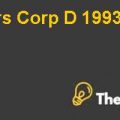
Question No. 1: What are the built-in tensions with a public private equity firm? How does Blackstone's structure attempt to reconcile them?
Answer:
The potential built-in tensions that Blackstone Group was facing were the transparency issues. The investors were agreed to have decline in the required rate of return just because of the transparency issues in the disclosures of the financial statements. Previously, the company has analyzed the business in which it was involved and concluded that it is not an investment company. The conclusion was studied by the SEC and it subsequently did not object. But on the other hand, after the conclusion by the management of the company, another problem arose in the shape of the compliance requirement with the US GAAP. Because, as an IPO company, the Blackstone Group must disclose its financial statements in accordance with the compliance requirements of GAAP. That was the main problem that Blackstone Group couldn’t completely resolve even after the proper adjustments in the financial statements disclosures and after the capital restructure.
Tension in the shape of employee turnover ratio was yet another problem for Blackstone Group. The employees’ resignations were driven by the change of compensation package. Just before an IPO issue, the bankers or underwriters of the company raised the issue about the unit holders of the company. Although the concept of an IPO would bring benefits and incentives to the existing LPs but in the meanwhile, that would neglect the future growth of the company after new deals. As proposed deals were closing, the part of interest of the unit holders and the employees would be transformed into units and would be withdrawn in the next eight years. Although, this will adjust both parties’ benefits but since the period of eight years was the problematic era, due to the risk of unpredictability over the stock prices. On the other hand, the management team have decided that the other part of the interest would be converted into carried interest as liability over the company can be converted into the shares immediately. Then, employees can both care about the benefits of unit holders and LPs. On the other hand, there was another problem of reduction in the shares proportion. For that reason, the company has created a pool of unissued shares and kept the shares in the pool at the 15% level of share proportion outstanding. As a result of any promotion the employees will get in the future, the shares will be withdrawn from the pool and will be rewarded to that employee and that will be a motivational factor for employees and thus lowering the employee turnover risk.
The tension of professional personnel resignation was yet another area of problem for the company. The main reason was the time horizon of eight years as the carried interest will face the vulnerability of stock prices hence the reason for job switching, and another reason was that after the conversion of part of interest carried into units, the personnel will cash it in from the market and resign from the job as well. For this reason, the company management have decided to go for the hybrid way.
Volatility of the stock prices was another problem for Blackstone Group. As the stock prices after IPO will surely be influenced not only by the quarterly disclosures of financial statements but also the economic environment of the country. In this sense, the investors of the company would value the short term performance over the long term strategic goals of the company. On the other hand, Blackstone was still more focused on the benefits of Limited Partners, means that unlike the investors, the company is more concerned about the long term strategic objectives rather than the short term financial performance.
The interference of the company’s management was another problem. In case management has decided to adopt the limited company structure, the members or shareholders of the company will also get the voting rights which will definitely reduce the control of management over the company. For this reason, the management of the company have decided to go for the MLP structure that will retain the limited partnership form structure that will allow the present management team to carry on with the business. Unit holders will have only restricted voting rights thus they will not be able to elect the director. By this, Blackstone Group can release its tensions about interference of management...........................
This is just a sample partial case solution. Please place the order on the website to order your own originally done case solution.
Stephen Schwarzman, chairman of Blackstone, has just learned that an investment group associated with the Chinese government wants to buy most leveraged IPO Blackstone's. As he considers how to respond to the offer, Schwartzman consider the proposed structure of the company as a public entity and assesses how it can keep a delicate balance between the parties, while maintaining liquidity in the market. "Hide
by G. Felda Hardymon, Josh Lerner, Ann Leamon Source: Harvard Business School 28 pages. Publication Date: Mar 05, 2008. Prod. #: 808100-PDF-ENG













